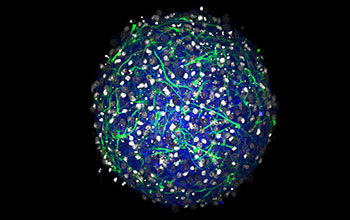Multimedia Gallery
Mini-brains advance human brain research
After 21 days in a culture, the mini-brain, originally derived from postnatal rat cortex, contains multiple cells including neurons (blue) and astrocytes (green). Nuclei are labeled in gray. The mini-brain was developed by a bioengineering team at Brown University and can form networks and are electrically active.
More about this image
The human brain contains about 86 billion nerve cells, billions of nerve fibers and trillions of connections between them. To probe this complex network, in 2015, National Science Foundation (NSF)-funded researchers developed a 3D model of about 8,000 nerve and supporting cells, described as a "mini-brain."
Unable to think but electrically active, the mini-brain offers an inexpensive, easy-to-make model to study nerve cell networks and the impact of drugs on nerve tissue or nerve tissue transplants. The mini-brain costs about a quarter to grow.
In 2017, the researchers discovered that the mini-brains produce networks of capillaries,
a critical feature needed to study brain conditions, injuries and diseases such as stroke,
concussions and Alzheimer’s disease. Researchers can now alter tissue conditions or introduce
drugs to observe tissue responses.
[Among the NSF support received for this research was a Graduate Research Fellowship awarded to Molly Boutin, co-lead author of a published paper about this research.]
To learn more about this research, see the Brown University news story An accessible approach to making a mini-brain. (Date image taken: 2016; date originally posted to NSF Multimedia Gallery: March 7, 2018)
Credit: Hoffman-Kim lab, Brown University
See other images like this on your iPhone or iPad download NSF Science Zone on the Apple App Store.
Images and other media in the National Science Foundation Multimedia Gallery are available for use in print and electronic material by NSF employees, members of the media, university staff, teachers and the general public. All media in the gallery are intended for personal, educational and nonprofit/non-commercial use only.
Images credited to the National Science Foundation, a federal agency, are in the public domain. The images were created by employees of the United States Government as part of their official duties or prepared by contractors as "works for hire" for NSF. You may freely use NSF-credited images and, at your discretion, credit NSF with a "Courtesy: National Science Foundation" notation.
Additional information about general usage can be found in Conditions.
Also Available:
Download the high-resolution JPG version of the image. (555.3 KB)
Use your mouse to right-click (Mac users may need to Ctrl-click) the link above and choose the option that will save the file or target to your computer.



